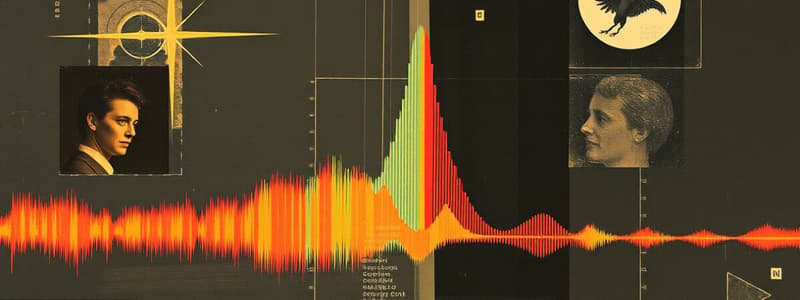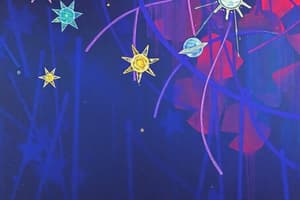Podcast
Questions and Answers
What is light?
What is light?
An electromagnetic wave
Describe how an absorption spectrum is formed.
Describe how an absorption spectrum is formed.
Electrons in an atom occupy the ground state. When white light is shone through a gaseous form of an element, the electrons absorb photons of light of specific energy. These frequencies of photon of light are then missing in the spectrum produced, instead there are dark lines showing the frequencies absorbed.
Describe how an emission spectrum is formed.
Describe how an emission spectrum is formed.
Electrons that have been excited are unstable and fall back to their ground state. When they fall, they release energy in the form of packets of specific energy (photons). These photons have specific energy and thus a specific frequency, producing colored lines on a black spectrum.
What does the quantization of energy absorbed by electrons show?
What does the quantization of energy absorbed by electrons show?
What is the relationship between the energy of a photon and an electron falling from one level to a lower one?
What is the relationship between the energy of a photon and an electron falling from one level to a lower one?
Why are only certain frequencies of light absorbed?
Why are only certain frequencies of light absorbed?
What is the convergence limit?
What is the convergence limit?
Why do lines on a spectrum converge?
Why do lines on a spectrum converge?
What does the convergence limit in a spectrum of an element show?
What does the convergence limit in a spectrum of an element show?
How is an emission spectrum of hydrogen produced?
How is an emission spectrum of hydrogen produced?
Why is the hydrogen spectrum the simplest?
Why is the hydrogen spectrum the simplest?
Which series of lines in the hydrogen emission spectrum fall within the visible region?
Which series of lines in the hydrogen emission spectrum fall within the visible region?
What energy level do hydrogen electrons fall to produce lines in the Balmer series?
What energy level do hydrogen electrons fall to produce lines in the Balmer series?
What transition in energy level of an electron of hydrogen produces a red line in the Balmer series?
What transition in energy level of an electron of hydrogen produces a red line in the Balmer series?
What transition in energy level of an electron of hydrogen produces a green line in the Balmer series?
What transition in energy level of an electron of hydrogen produces a green line in the Balmer series?
What transition in energy level of an electron of hydrogen produces a blue line in the Balmer series?
What transition in energy level of an electron of hydrogen produces a blue line in the Balmer series?
What transition in energy level of an electron of hydrogen produces a violet line in the Balmer series?
What transition in energy level of an electron of hydrogen produces a violet line in the Balmer series?
Where does the Lyman series fall in the electromagnetic spectrum?
Where does the Lyman series fall in the electromagnetic spectrum?
What energy level do hydrogen electrons fall to produce lines in the Lyman series?
What energy level do hydrogen electrons fall to produce lines in the Lyman series?
How does the convergence limit in the Lyman series relate to the ionization energy of hydrogen?
How does the convergence limit in the Lyman series relate to the ionization energy of hydrogen?
How does the energy of a photon relate to its frequency?
How does the energy of a photon relate to its frequency?
Between Wave one with a wavelength of 695nm and Wave two with a wavelength of 802nm, which wave has higher energy and why?
Between Wave one with a wavelength of 695nm and Wave two with a wavelength of 802nm, which wave has higher energy and why?
Study Notes
Light and Electromagnetic Waves
- Light is defined as an electromagnetic wave.
Absorption Spectrum Formation
- Electrons in an atom occupy ground states and absorb specific energy photons from white light.
- Photons of certain frequencies are absorbed, resulting in dark lines in the produced spectrum, indicating missing frequencies.
Emission Spectrum Formation
- Excited electrons release energy as they return to ground states, emitting photons with specific energies.
- These emitted photons create colored lines on a dark background in the spectrum, corresponding to their frequencies.
Quantized Energy Levels
- Electrons absorb and emit energy only in discrete amounts, demonstrating that they occupy fixed energy levels.
Photon Energy and Quantum
- The energy of a photon released during an electron's transition equals the energy difference between the two levels and is termed a quantum of energy.
Frequency Absorption
- Only certain frequencies of light are absorbed due to their correspondence with quantized energy levels of electrons.
Convergence Limit
- The convergence limit occurs when spectral lines approach each other at higher frequencies, eventually merging at n = infinity.
Reason for Spectrum Convergence
- Lines on a spectrum converge because higher energy levels come closer together as energy increases.
Ionisation Energy and Convergence Limit
- The convergence limit indicates an element's ionisation energy, calculated using the equation E = hf.
Producing Hydrogen's Emission Spectrum
- An electric discharge through gas gives rise to hydrogen's emission spectrum.
Simplicity of Hydrogen Spectrum
- The hydrogen emission spectrum is the simplest due to having only one electron.
Visible Region: Balmer Series
- The Balmer series consists of lines in the hydrogen emission spectrum that fall within the visible region of the electromagnetic spectrum.
Balmer Series Energy Level Transitions
- Lines in the Balmer series are produced when hydrogen electrons transition to n = 2.
- Specific transitions create different colors:
- Red: n = 3 to n = 2
- Green: n = 4 to n = 2
- Blue: n = 5 to n = 2
- Violet: n = 6 to n = 2
Lyman Series and Wavelengths
- The Lyman series occurs in UV wavelengths, with transitions falling to n = 1.
Convergence Limit and Ionisation Energy in Lyman Series
- Convergence in the Lyman series relates to hydrogen's ionisation energy, corresponding to the transition from n = 1 to n = infinity.
Energy-Frequency Relationship
- The energy of a photon is directly proportional to its frequency, expressed by the equation E = hf.
Wave Energy Comparison
- Wave one (695nm) has higher energy than wave two (802nm) due to its smaller wavelength, leading to a greater frequency, which is consistent with E = hf.
Studying That Suits You
Use AI to generate personalized quizzes and flashcards to suit your learning preferences.
Description
Test your knowledge on absorption and emission spectra with this flashcard quiz. Learn about the properties of light and how absorption spectra are formed. Perfect for students studying chemistry or physics!




